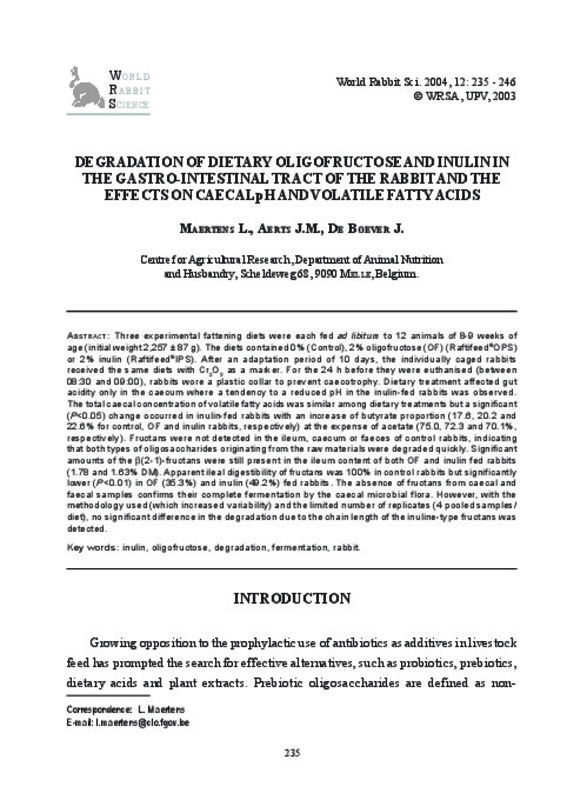JavaScript is disabled for your browser. Some features of this site may not work without it.
Buscar en RiuNet
Listar
Mi cuenta
Estadísticas
Ayuda RiuNet
Admin. UPV
Degradation of dietary oligofructose and inulin in the gastro-intestinal tract of the rabbit and the effects on caecal pH and volatile fatty acids
Mostrar el registro sencillo del ítem
Ficheros en el ítem
| dc.contributor.author | Maertens, L.
|
|
| dc.contributor.author | Aerts, J.M.
|
|
| dc.contributor.author | De Boever, J.
|
|
| dc.date.accessioned | 2011-02-14T10:26:35Z | |
| dc.date.available | 2011-02-14T10:26:35Z | |
| dc.date.issued | 2004 | |
| dc.identifier.issn | 1257-5011 | |
| dc.identifier.uri | http://hdl.handle.net/10251/9766 | |
| dc.description.abstract | [EN] Three experimental fattening diets were each fed ad libitum to 12 animals of 8-9 weeks of age (initial weight 2,257 ± 87 g). The diets contained 0% (Control), 2% oligofructose (OF) (Raftifeed(R) OPS) or 2% inulin (Raftifeed(R) IPS). After an adaptation period of 10 days, the individually caged rabbits received the same diets with Cr2O3 as a marker. For the 24 h before they were euthanised (between 08:30 and 09:00), rabbits wore a plastic collar to prevent caecotrophy. Dietary treatment affected gut acidity only in the caecum where a tendency to a reduced pH in the inulin-fed rabbits was observed. The total caecal concentration of volatile fatty acids was similar among dietary treatments but a significant (P<0.05) change occurred in inulin-fed rabbits with an increase of butyrate proportion (17.6, 20.2 and 22.6% for control, OF and inulin rabbits, respectively) at the expense of acetate (75.0, 72.3 and 70.1%, respectively). Fructans were not detected in the ileum, caecum or faeces of control rabbits, indicating that both types of oligosaccharides originating from the raw materials were degraded quickly. Significant amounts of the b(2-1)-fructans were still present in the ileum content of both OF and inulin fed rabbits (1.78 and 1.63% DM). Apparent ileal digestibility of fructans was 100% in control rabbits but significantly lower (P<0.01) in OF (35.3%) and inulin (49.2%) fed rabbits. The absence of fructans from caecal and faecal samples confirms their complete fermentation by the caecal microbial flora. However, with the methodology used (which increased variability) and the limited number of replicates (4 pooled samples/diet), no significant difference in the degradation due to the chain length of the inuline-type fructans was detected. | es_ES |
| dc.description.sponsorship | The authors are grateful to the Orafti company (Tienen, Belgium) for their financial and analytical support. They acknowledge the skilled technical support of A. Vermeulen and J. M. Vanacker. | |
| dc.language | Inglés | es_ES |
| dc.publisher | World Rabbit Science. ICTA. UPV | es_ES |
| dc.relation.ispartof | World Rabbit Science | |
| dc.rights | Reserva de todos los derechos | es_ES |
| dc.subject | Inulin | es_ES |
| dc.subject | Oligofructose | es_ES |
| dc.subject | Degradation | es_ES |
| dc.subject | Fermentation | es_ES |
| dc.subject | Rabbit | es_ES |
| dc.title | Degradation of dietary oligofructose and inulin in the gastro-intestinal tract of the rabbit and the effects on caecal pH and volatile fatty acids | es_ES |
| dc.type | Artículo | es_ES |
| dc.date.updated | 2011-02-14T10:16:16Z | |
| dc.identifier.doi | 10.4995/wrs.2004.569 | |
| dc.rights.accessRights | Abierto | es_ES |
| dc.description.bibliographicCitation | Maertens, L.; Aerts, J.; De Boever, J. (2004). Degradation of dietary oligofructose and inulin in the gastro-intestinal tract of the rabbit and the effects on caecal pH and volatile fatty acids. World Rabbit Science. 12(4):235-246. https://doi.org/10.4995/wrs.2004.569 | es_ES |
| dc.description.accrualMethod | SWORD | es_ES |
| dc.relation.publisherversion | https://doi.org/10.4995/wrs.2004.569 | |
| dc.description.upvformatpinicio | 235 | |
| dc.description.upvformatpfin | 246 | |
| dc.description.volume | 12 | |
| dc.description.issue | 4 | |
| dc.identifier.eissn | 1989-8886 | es_ES |
| dc.contributor.funder | Beneo-Orafti, S.A. |








